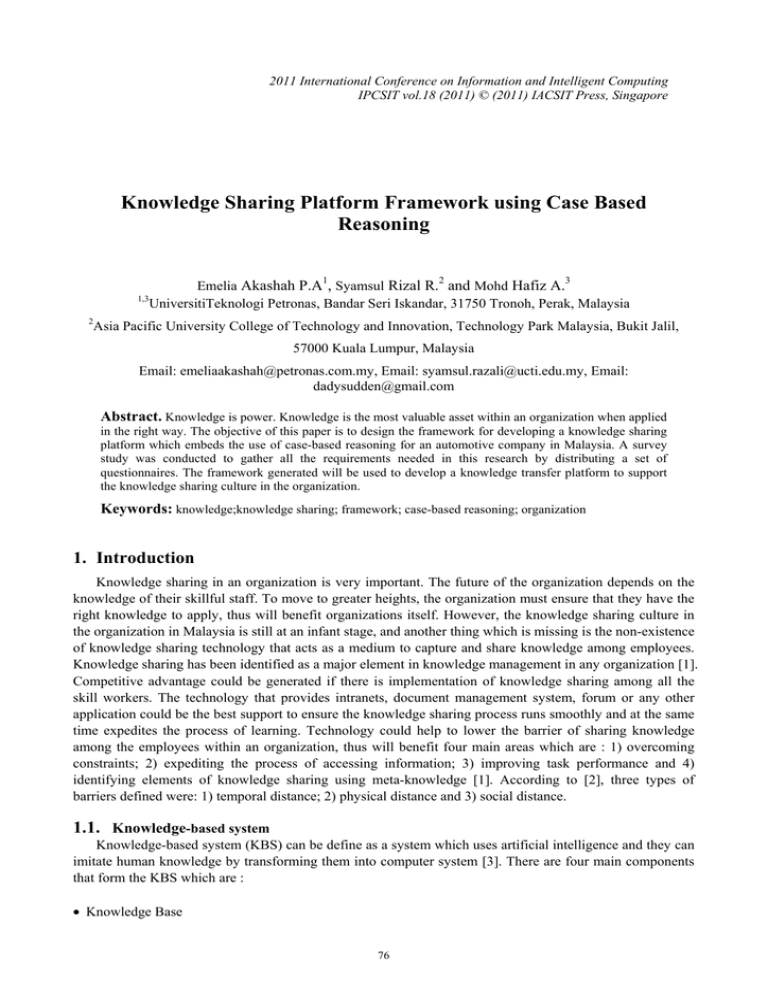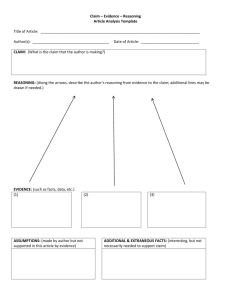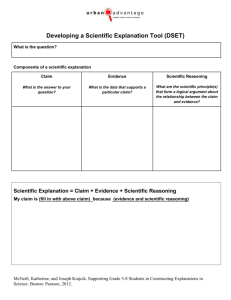Document 13135853
advertisement

2011 International Conference on Information and Intelligent Computing IPCSIT vol.18 (2011) © (2011) IACSIT Press, Singapore Knowledge Sharing Platform Framework using Case Based Reasoning 1 1,3 2 2 3 Emelia Akashah P.A , Syamsul Rizal R. and Mohd Hafiz A. UniversitiTeknologi Petronas, Bandar Seri Iskandar, 31750 Tronoh, Perak, Malaysia Asia Pacific University College of Technology and Innovation, Technology Park Malaysia, Bukit Jalil, 57000 Kuala Lumpur, Malaysia Email: emeliaakashah@petronas.com.my, Email: syamsul.razali@ucti.edu.my, Email: dadysudden@gmail.com Abstract. Knowledge is power. Knowledge is the most valuable asset within an organization when applied in the right way. The objective of this paper is to design the framework for developing a knowledge sharing platform which embeds the use of case-based reasoning for an automotive company in Malaysia. A survey study was conducted to gather all the requirements needed in this research by distributing a set of questionnaires. The framework generated will be used to develop a knowledge transfer platform to support the knowledge sharing culture in the organization. Keywords: knowledge;knowledge sharing; framework; case-based reasoning; organization 1. Introduction Knowledge sharing in an organization is very important. The future of the organization depends on the knowledge of their skillful staff. To move to greater heights, the organization must ensure that they have the right knowledge to apply, thus will benefit organizations itself. However, the knowledge sharing culture in the organization in Malaysia is still at an infant stage, and another thing which is missing is the non-existence of knowledge sharing technology that acts as a medium to capture and share knowledge among employees. Knowledge sharing has been identified as a major element in knowledge management in any organization [1]. Competitive advantage could be generated if there is implementation of knowledge sharing among all the skill workers. The technology that provides intranets, document management system, forum or any other application could be the best support to ensure the knowledge sharing process runs smoothly and at the same time expedites the process of learning. Technology could help to lower the barrier of sharing knowledge among the employees within an organization, thus will benefit four main areas which are : 1) overcoming constraints; 2) expediting the process of accessing information; 3) improving task performance and 4) identifying elements of knowledge sharing using meta-knowledge [1]. According to [2], three types of barriers defined were: 1) temporal distance; 2) physical distance and 3) social distance. 1.1. Knowledge-based system Knowledge-based system (KBS) can be define as a system which uses artificial intelligence and they can imitate human knowledge by transforming them into computer system [3]. There are four main components that form the KBS which are : • Knowledge Base 76 • Inference engine • Knowledge engineering tools • Specific user interface Reference [4] stated that the KBS framework has divided knowledge into two levels which are organization and information system. 1.2. Case-based reasoning Case-based reasoning (CBR) is part of artificial intelligent which is used for reasoning and learning [5]. By using CBR, all the records or cases of the previous problem solving will be stored in the repository so that when the new cases are developed, they can be solved by referring to the previous cases. All the cases developed will be reuse in the future, thus making the learning process faster. Instead of generating the way of solving problem from scratch, CBR will help in improving the efficiency of reasoning [5]. CBR could be applied to two different purpose which are : 1)problem solving and 2) interpretation. Figure 1 shows the process of CBR in a cycle comprising the 4 R’s [6]: • • • • Retrieve - cases will be retrieved from the system or library of cases Reuse – similar cases that have been retrieved will be used in attempts to solve a problem Revise – proposed solutions by the system will be revised by the user Retain – all of the problem that have been solved will be saved as part of a new case Figure 1 . CBR cycle [7] Other than problem solving and interpretation, CBR can also act as learning tool. Some of the advantages of using CBR as a learning tool are [7] : • Remembers and adapts to old solution • More competent over time • Enables prototype system to start with a little amount of cases and increases its coverage over time. In bridging the gap between theory and practice, it is believed that video cases is the best option to adopt, because it could help people to learn the new lesson quickly if compared to other methods besides of its convenience where people just need to stay at home to learn how to accomplish any of the task they prefer [8,9]. There are four criteria that has been defined to enable people to better understand how teaching and explaining something using short durational video can be really an effective method [10]. The first criteria is body language which explains how people use their body parts (hands, body and face) when teaching. Teaching procedure is involved in deciding which methods is the best for the people to follow based on observation. Observation on types of resources and technical characteristics is the third criteria need to be considered. The final criteria is to observe the person or actor in the video and to reason the presence [10]. 2. Methodology In carrying out this research study, data is collected from a group of employee from the automotive company in Malaysia. A survey or questionnaire will be conducted in order to gather the requirements for this system. The numbers of expected respondent that will answer the survey are approximately 50 77 respondents. The questionnaire comprised of both open-ended and close-ended types of questions. The purpose of this survey is to acquire important information for the development of effective knowledge sharing programmes and initiatives that are directly relevant to the organization operation’s specific knowledge sharing needs. The input from the survey would be used to assess knowledge sharing requirement amongst individual staff and also will be used in assessing the features that will be included in the proposed system. 3. Result and Discussion The framework has been developed based on the requirements gathered. The structure runs under three different tiers such as Interface Tier, Application Tier, and Data Tier. Each tier runs different function in order to operate the system smoothly. The Interface Tier holds the Graphical User Interface (GUI) of the system which facilitates the connection between the user and the system. The GUI could assist user to interact with the system. It is also use to help the system to get input data from the user such as login details, car’s symptoms, participate in forum and also communication data between users towards the system. The data tier will holds all data and information in the centralized database. All the files that were related to the knowledge sharing platform have been uploaded to a hosting server using tools like FileZilla and CPanel. FileZilla is an application that supports File Transfer Protocol (FTP), while CPanel is a web hosting control panel that provides a graphical interface and automation tools designed to simplify the process of hosting a web site. The data and information stored in the database includes login details, car’s recommended solution, file shared, video collection, communication data between users especially in forum, members information, latest news, and also messages from users if they have any inquiry. Lastly, the application tier connect these two tiers various functions in order to get the necessary data, communicate with other users, and analyze the results based on the symptoms selected for the Diagnostic Module. Figure 2 is the flow chart for the ‘To-Be’ system for this knowledge sharing platform. There are four core modules or functions and two additional minor modules that have been developed. The core modules of this system are Auto File, Auto Video, Auto Forum, and Auto Care, while the two additional minor modules are News and Contact Page. Figure 2 . Flow chart of knowledge sharing platform Explaining about the core modules, the Auto File is a module which was developed to enable user to download any important files that has been shared in the company’s server. For this module, only admin personnel that were authorized to handle this knowledge sharing platform are able to upload and shared any files to the server, such as .doc, .pdf, .mp3 and many more, while normal user just can view and download 78 the file from the server. Auto Video is a function which is developed to make user able to view video that has been shared into the server. The purpose of having this video collection module is to enhance user’s learning experience from the knowledge sharing platform. Videos from YouTube or from local computers can be directly embedded only by the admin of this portal. Users can also feel the power of collaboration through this portal, by involving in the Auto Forum. Auto Forum is a module or function that has been developed for the purpose of sharing knowledge and collaboration. This forum follows the typical online forum that is available in many web sites on the World Wide Web. In this forum, new users have to register and login as a member of the forum community in order for them to be able to post topic or post any comments. The registrations of new users are needed in order to prevent the existence of any anonymous user, and also to make them feel responsible of their behavior in the discussions. The last core module for the system is Auto Care. AutoCare is a function or module that have been developed for the purpose of assisting user to diagnose their car’s problem and solutions, based on their car’s symptoms. In this function, user just have to select what are the symptoms that their car is having and the system will generate the possible problems and recommended solutions accordingly. Minor module, which is News page is developed to make user able to read the latest news in the company and the industry from the portal. User also can contact admin if they have any inquiry regarding to the knowledge sharing platform. For this function, an inquiry form which consists of details like sender’s name, their email and also their message is provided. After user has submitted this form, site admin will receive the message to the knowledge sharing platform email. The use case diagram is used to show the interaction between various actors and the task carried out by the system. Figure 3 shows that user and administration or moderator of the system can view information such as discussion topics, diagnostic results, files shared, and also videos shared in the system. Users also can involve in discussion, do car’s problems diagnosis, and send their messages or inquiries to the admin and also download the file that has been shared in the system. In this system, only admin can update the database, do maintenance, and do any changes or modification to the system. Figure 3 . Use case of knowledge sharing platform 4. Conclusion Case based reasoning is definitely the best method to be adopted by the proposed knowledge sharing platform to be used in this particular organization. Besides to facilitate the knowledge transfer among the employees, it could provide a secure place to store the knowledge obtained in the organization. This research has successfully developed a customize framework of the system. Thorough research is carried out while gathering the system requirements to ensure that the developed framework is practical to be used for knowledge transfer. For future research, knowledge sharing platform will be developed based on the framework proposed in this research paper by implementing case-based reasoning. 79 5. References [1] H. Paul, “Why Share Knowledge? Influence of ICT on the Motivation for Knowledge Sharing,”. Knowledge and Process Management, vol.2, 1999, pp 91-100. [2] G.David, “Creating a Knowledge Sharing Culture,”, Knowledge Management Magazine, vol. 2,1999. [3] K. Soonhee, L. Hyangsoo, The impact of Organizational Context and Information Technology on Employee Knowledge Sharing Capability, Public administration review,2006,vol. 66, pp. 370-385. [4] H.D. Jeffrey, W.H. Nile, “Relation-specific capabilities and barriers to knowledge transfer: Creating Advantages through Network Relationship,”, Strategic Management Journal,vol.27, 2006, pp.701-719. [5] N. Robert, F. Richard, F. Tim, G. Thomas, P.Ramesh, S.Ted, R.S William, Enabling Technology for Knowledge Sharing, AI Magazine, vol.12, 1999. [6] G. Thomas, Toward Principles for the design used of Ontologies Used for Knowledge Sharing, International Workshop on Formal Ontology, Padova, Italy,March 1993. [7] W. Ian, M.Farhi, Case Based Reasoning: A Review, The Knowledge Engineering Review, Cambridge University Press, 1994,pp.327-354. [8] I. Laso-Ballesteros, Collaboration at work 2020: Ubiquitous Collaboration Research Perspectives, Proceedings of the 15th IEEE International Workshops on Enabling Technologies: Infrastructures for Collaborative Enterprises, Manchester, United Kingdom,2006. [9] M. Mark, Collaboration Operations: Ensuring Success, Proceedings of the International Symposium on the Collaborative Technologies and Systems, 2005. [10] L. Hui, C. Dipanjan, C. Henry, J.D. Michael, H.Terry, S.L. Jenny, N. Nitin, P.Yasudhar, Contextual Collaboration: Platform and Applications, Proceedings of IEEE International Conference on Services Computing,2004. 80




